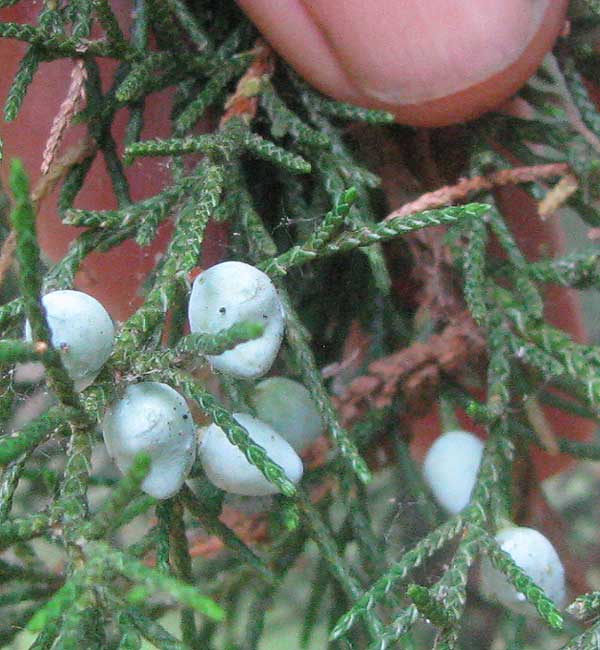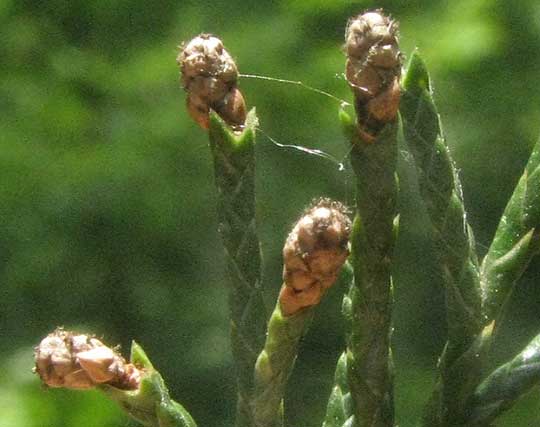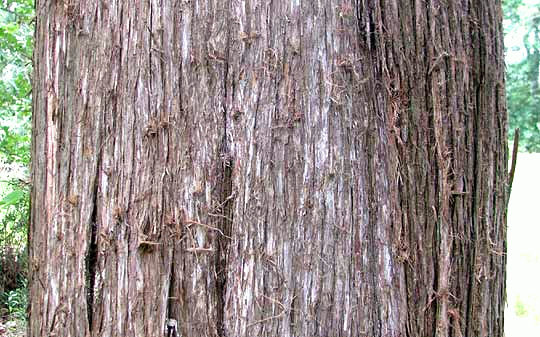Excerpts from Jim Conrad's
Naturalist Newsletter

from the June 17, 2012 Newsletter issued from the woods of the Loess Hill Region a few miles east of Natchez, Mississippi, USA
REDCEDARS WITH BLUISH CONES
In abandoned fields and along roadsides throughout the eastern US and adjacent southern Canada one of the best-known and easy-to-identify trees is the Eastern Redcedar, JUNIPERUS VIRGINIANA. In natural areas over most of its distribution it can only be confused with pines, which in aspect are more open, plus of course pines bear pine needles, not the Redcedar's overlapping scales. Nowadays some of our Redcedars are laden with bluish, 1/5th-inch wide (5mm) cones, as shown among their scaly, much branching stems above.
Why are these "cones" and not "berries"? In this case, you just have to know the botany, because otherwise they do seem to be berries, which are pulpy fruits containing more than one seed and not splitting open at maturity. The Redcedar's fruits are cones because they are formed from several flower scales that fused together as the fruiting body enlarged. Out West where several members of the Redcedar's genus Juniperus are found (the junipers), cones on those species often consist of scales not as neatly fused as the ones on Redcedars, and they look more like regular cones. Redcedars are members of the Cypress Family, the Cupressaceae, so they're gymnosperms like pines and spruce, and you know that those trees produce cones. The Redcedar just does a good job making their cones look like berries.
Redcedars typically come in male or female trees -- they're dioecious -- though sometimes one tree can bear both male and female flowers. That explains why some of our trees are full of cones but others have none. On the ones without cones, if you look closely you can find tiny, egg-shaped, 1/8th-inch-long (3.5mm) catkins composed of clustered anthers, with their pollen released weeks ago, as shown below:

Ecologically, Eastern Redcedars are very important because they can quickly invade abandoned or burnt-over fields by way of bird poop dropped from the sky. Studies show that it takes about 12 minutes for redcedar seeds to pass through a Cedar Waxwing's guts, and seeds that do pass through germinate about three times better than those of seeds not eaten by birds.
You can see the Redcedar's bark, which comes off (exfoliates) in strips, not in plates the way it happens on some western juniper species, below:

Notice the relationship between the words redcedar and juniper. The West's several juniper species as well as our Eastern Redcedar are all members of the genus Juniperus, so they're all junipers. It's just that by tradition the East's junipers are called Redcedars.
The tree's wood is very durable, prettily colored and aromatic. When I was a kid on the Kentucky farm, people used Eastern Redcedars as their "Christmas trees," so of course when I smell the redcedar's resiny fragrance I have flashbacks to Christmases past.
Indigenous Americans once made bows from redcedar wood. Juniper oil, much used in aromatherapy, is distilled from the wood and branches. The oil is said to increase kidney function, relieve dehydration, treat ulcers, and other health problems, plus it's used in cosmetics due to its antibacterial and anti-inflammatory properties. The cones are used to flavor gin